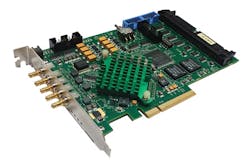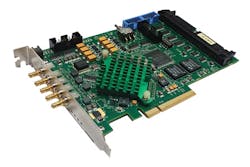High-speed imaging: CXP image splitter replicates data across PCs
One of the fastest camera-to-computer interfaces available today is CoaXPress (CXP), an asymmetric point-to-point serial communication standard that has a high speed downlink of up to 6.25Gbps per channel and a lower speed, 20Mbps uplink for communication and control. Today, a number of high-speed camera companies and frame grabber vendors offer cameras and frame grabbers with up to four channels that are capable of supporting data rates as high as 25Gbps.
"With the high-data rate of such systems," says Donal Waide, Director of Sales at BitFlow (Woburn, MA, USA;www.bitflow.com), "it is often necessary to distribute the task of processing such data across multiple computers. In other cases, the systems developers may wish to send CXP images to more than one infrastructure, such as a real time system and a backup off-line system." Thus, it is necessary to distribute the CXP image data to accomplish this task; a function that cannot be accomplished by simply splitting the cable as it is with analog systems.
Because of this, BitFlow has developed a prototype board that allows image data from one link of a CXP camera to transfer images to up to four separate PCs. Code named Gatana, the board was first shown in operation at May's Vision Show in Boston and will be officially released as a CXP Replicator.
At the show, the company showed how four of these boards can be used in conjunction with two of the company's Cyton-CXP frame grabbers to replicate image data from a 2560 x 2048 CMOS-based SP-500 CXP4 camera from JAI (San Jose, CA, USA;www.jai.com) to two PC-based systems. "However," as Waide explains, "the board can be used to support up to four such computer systems."
While at first resembling a CXP frame grabber, the board features five DIN 1.0/2.3 connectors. To replicate image data to four computer systems, CXP data from each of the four channels of the SP-500 CXP4 camera would be input to one channel (the top channel in the image above) of each of four separate replicators, each housed in a stand-alone chassis. Data from the four outputs of each replicator would then be input into the four channels of four separate Cyton-CXP frame grabbers each one located in the PCI Express chassis.
"Since the same images are sent to each of the four frame grabbers," says Waide, "the systems developer can choose to perform disparate image processing operations on each image and separately display these images." In such a configuration, the CXP Replicator provides power to the camera and the frame grabbers provide power to the CXP Replicator. While the CXP Replicator currently operates only with BitFlow frame grabbers, the company plans to work with other third-party CXP frame grabber vendors, should this be required.
Such systems are not exactly inexpensive. To configure a four system set-up for a single four-channel CXP camera, for example, requires four CXP Replicators and four frame grabbers. "However," says Waide, "in applications where redundancy is mandatory, cost is not an issue."

